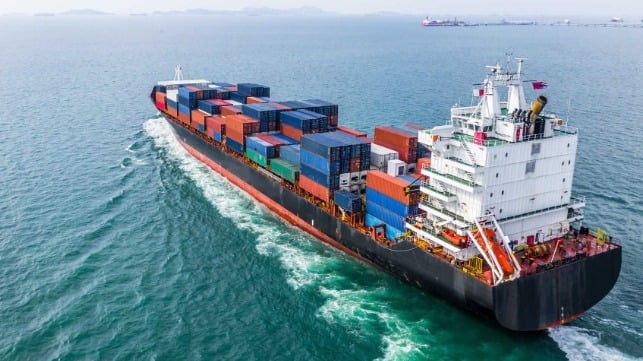Fuel Cells are Making Waves in a Centuries-Old Industry

The maritime shipping industry keeps the global economy humming, with 90 percent of world trade taking place by sea. This outsized reliance on shipping means the industry can also bring worldwide commerce to a halt, as evidenced by the recent grounding of a cargo ship, the Ever Given, in the Suez Canal that triggered a floating traffic jam of more than 400 ships.
With more than 90,000 ships making up the world's commercial fleet, carbon emissions from shipping alone account for approximately three percent of the world’s CO2. Modernizing one of the world’s oldest forms of trade with cutting-edge, clean energy technology is no small task. It is important that marine trade vessels use energy that is clean and efficient, but it is not simply a matter of swapping one engine out for another.
Internal combustion engines (ICEs) are the most common form of propulsion and power on large sea vessels. ICEs have traditionally run on heavy fuel oil, an extremely polluting fuel. While heavy fuel oil is a plentiful resource, it is also one of the dirtiest fuels in the world. Published studies have recognized the impact that burning heavy fuel oil has on the climate, prompting both governments and maritime organizations to set emissions standards in an effort to curb the negative effects. The International Maritime Organization (IMO) has established guidelines for all cargo ship operators suggesting that by the year 2050, CO2 emissions from cargo ships should be half what they were in 2008. This has left the marine industry searching for ways to meet this goal.
The Solution is Here
The answer is fuel cells. Fuel cells are a highly efficient form of electricity production that will put us on a path to cleaner fuels, and will help ship owners, builders and partners reach IMO mandates. Bloom Energy’s fuel cells are fuel-flexible, meaning they can run on readily available natural gas, hydrogen, biogas or blends of any of those. And, our fuel cell technology has excelled at powering massive loads like stadiums, manufacturers and other large facilities on land. It makes sense that the same technology would be equally effective at sea.
By adopting land-based fuel cells for maritime applications, proposed designs of fuel cell-powered ships would have more than enough power to keep a working vessel, well . . . working. Natural gas fuel cells significantly reduce CO2 emissions and decrease smog-forming pollutants and particulate matter, like NOx and SOx, by more than 99 percent compared to entrenched power sources.
Maritime certification
The certification process for marine fuel cells is a rigorous process, requiring that new technologies undergo a variety of operating scenarios to ensure they can withstand the rigors of the weather and use at sea. Classification societies like American Bureau of Shipping (ABS), Lloyd’s Register and DNV-GL expect any new maritime technologies to stand up to the rigors of maritime use.
Stringent certification standards require rigorous testing in an industry that already has centuries of rules and regulations. New technologies for ships should meet both current regulations and demonstrate alignment to future standards.
Given there is not an experience record for new technologies in maritime applications, concerns relative to safety, durability and effectiveness must be addressed. The New Technology Qualification (NTQ) process is designed to address those concerns by providing guidance and recommendations to assure a smooth, low risk adoption of the technology into maritime use. Bloom is currently working on its NTQ, to confirm its technology performs intended functions in accordance with defined performance requirements. Once the NTQ is completed, Bloom Energy plans to continue with the ABS certification process, which ensures that the technology goes through a technical evaluation and study of production compliance.
Rough waters call for rougher testing
Fuel cell technology for the marine environment differs greatly from fuel cells deployed on land. Ships and their onboard equipment must withstand and continue to operate effectively and safely with the constant motion of the ship and, at times, turbulent seas.
Vibration testing shakes the equipment at defined frequencies and durations, replicating the constant vibrations often felt on vessels. Similarly, tilt testing imitates a range of motions that a ship may encounter navigating rough seas. Pitch, yaw, and roll motions on the tilt platform mimic specified angles and intervals to demonstrate the technology’s readiness for use on water. Tests like these ensure that power generation is uninterrupted in rough sea situations when the crew needs dependable power most.
Making waves in a centuries-old industry
And, the testing and certification process is the easy part. Getting new technology aboard ships is not as simple as taking a vessel to a shipyard to be retrofitted. Maritime vessels are built around their power systems, meaning fuel cells must be included at the design phase. Ships being built now likely will not sail for several years.
As a result, marine fuel cells change the future of ship design. No longer encumbered by centralized engine rooms, the modularity, customization, and low-profile footprint benefits of fuel cells give maritime vessels more flexibility in design, which can allow a more efficient hull design, expanded cargo space and enhanced resiliency.
Bloom Energy is making headway into helping shipping organizations meet emissions and efficiency regulations by moving power generation to cleaner alternative fuels, like natural gas and hydrogen. As regulations on maritime emissions become more environmentally focused, fuel cell technology will enable vessels to meet these standards.
Timothy Schweikert serves as senior advisor, market development, marine solutions for Bloom Energy, where he is focused on developing fuel cell-powered ships. Prior to Bloom, Tim spent over 30 years with General Electric, holding a variety of leadership positions spanning aviation, rail transportation, and marine.
The opinions expressed herein are the author's and not necessarily those of The Maritime Executive.
